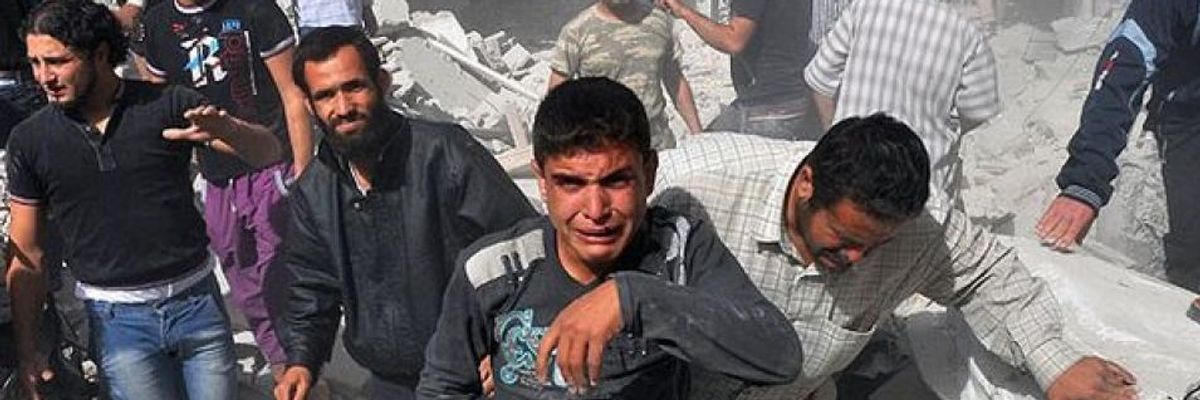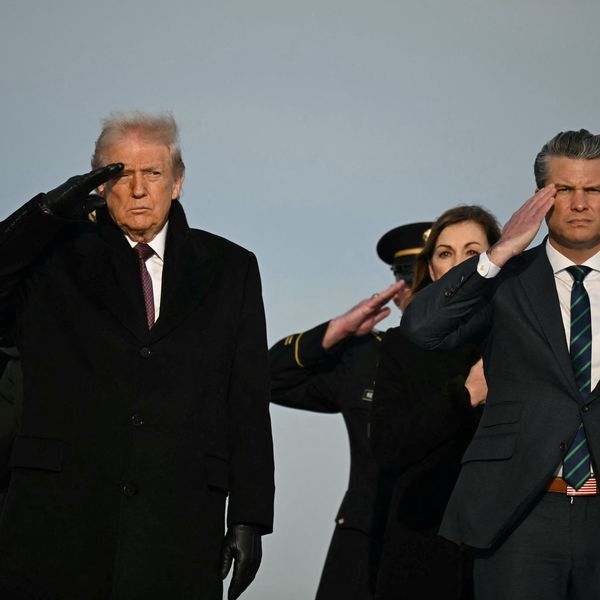
"The regime deliberately used heavy weapons to target peaceful, civilian protesters, in hopes of making them militant so that they could be denounced to the outside world as terrorists." (Credit: Bulent Kilic / AFP / Getty Images)
Trump's Disastrous Year In The Middle East
Chaos in Syria.
Trump on the campaign trail said many self-contradictory things about the Syrian civil war. He wanted to carpet bomb ISIL, which had a strip of territory in the far east of the country. He wanted to send in 30,000 US troops, he said at one point. Then at other times he argued that "we" should just "let Russia handle it."
As it happened, the Pentagon under Ash Carter, Obama's secretary of defense, had worked up a plan to defeat ISIL and to deprive them of their caliphate by giving close air support to the Syrian leftist Kurds of the northeast.
Trump did not innovate in any way, he just had SecDef Jim Mattis go on doing in eastern Syria what Ash Carter had been doing. The US air force and aerial allies such as France bombed ISIL in their capital, Raqqa, and gave air support to the YPG Kurds, who gradually advanced to the center of the city and then took it away from ISIL. The capital of their so-called caliphate had lasted for only three years before they lost it.
As the action then picked up south of Raqqa, the Syrian Arab Army troops of al-Assad combined forces with the Russian Aerospace Forces to finish off ISIL. The US and its Kurdish allies did take some of Deir al-Zor province, but down there the regime reasserted itself.
So Trump, like Obama, helped maintain a buffer zone around the Syrian Kurds with 2,000 special ops troops.
But aside from putting down that marker for a sphere of influence in the Jazira, the northeast of the country, Trump has done almost nothing else.
Meanwhile, al-Assad and the Baath regime used their Shiite auxiliaries from Lebanon and Iraq and Russian air fire to further consolidate control over much of the country.
They lack the East Ghouta pocket outside the capital of Damascus, and likewise they lack Idlib province in the north.
Trump intervened briefly in Syria, where he dropped some Tomahawk missiles on a base he was convinced were being used for delivery of chemical weapons.
It was a one-time intervention, followed by ... nothing.
In the meantime, al-Assad and Russia are gradually, and brutally, reestablishing regime control.
So of all his campaign promises, Trump's actions came closest to the version where he lets Syria go to the Russians. The only wrinkle is the 2000 spec ops guys in the northeast among the leftist-anarchist Kurds.
Since Turkey doesn't like that and al-Assad/Russia doesn't, at some point Trump will have to decide whether the US troop presence there is a low priority or a high one. If the former, he'll have to withdraw or face terrorist strikes. If the latter, he may come into direct conflict with shadowy troops belonging to someone or another. In other words, there may yet be a battle royale.
The 2011 youth revolt in Syria was turned by the al-Assad regime into a civil war. The regime deliberately used heavy weapons to target peaceful, civilian protesters, in hopes of making them militant so that they could be denounced to the outside world as terrorists. While outside money played a role in radicalization, most of that preexisted the outside money and was homegrown.
An Urgent Message From Our Co-Founder
Dear Common Dreams reader, The U.S. is on a fast track to authoritarianism like nothing I've ever seen. Meanwhile, corporate news outlets are utterly capitulating to Trump, twisting their coverage to avoid drawing his ire while lining up to stuff cash in his pockets. That's why I believe that Common Dreams is doing the best and most consequential reporting that we've ever done. Our small but mighty team is a progressive reporting powerhouse, covering the news every day that the corporate media never will. Our mission has always been simple: To inform. To inspire. And to ignite change for the common good. Now here's the key piece that I want all our readers to understand: None of this would be possible without your financial support. That's not just some fundraising cliche. It's the absolute and literal truth. We don't accept corporate advertising and never will. We don't have a paywall because we don't think people should be blocked from critical news based on their ability to pay. Everything we do is funded by the donations of readers like you. Will you donate now to help power the nonprofit, independent reporting of Common Dreams? Thank you for being a vital member of our community. Together, we can keep independent journalism alive when it’s needed most. - Craig Brown, Co-founder |
Trump on the campaign trail said many self-contradictory things about the Syrian civil war. He wanted to carpet bomb ISIL, which had a strip of territory in the far east of the country. He wanted to send in 30,000 US troops, he said at one point. Then at other times he argued that "we" should just "let Russia handle it."
As it happened, the Pentagon under Ash Carter, Obama's secretary of defense, had worked up a plan to defeat ISIL and to deprive them of their caliphate by giving close air support to the Syrian leftist Kurds of the northeast.
Trump did not innovate in any way, he just had SecDef Jim Mattis go on doing in eastern Syria what Ash Carter had been doing. The US air force and aerial allies such as France bombed ISIL in their capital, Raqqa, and gave air support to the YPG Kurds, who gradually advanced to the center of the city and then took it away from ISIL. The capital of their so-called caliphate had lasted for only three years before they lost it.
As the action then picked up south of Raqqa, the Syrian Arab Army troops of al-Assad combined forces with the Russian Aerospace Forces to finish off ISIL. The US and its Kurdish allies did take some of Deir al-Zor province, but down there the regime reasserted itself.
So Trump, like Obama, helped maintain a buffer zone around the Syrian Kurds with 2,000 special ops troops.
But aside from putting down that marker for a sphere of influence in the Jazira, the northeast of the country, Trump has done almost nothing else.
Meanwhile, al-Assad and the Baath regime used their Shiite auxiliaries from Lebanon and Iraq and Russian air fire to further consolidate control over much of the country.
They lack the East Ghouta pocket outside the capital of Damascus, and likewise they lack Idlib province in the north.
Trump intervened briefly in Syria, where he dropped some Tomahawk missiles on a base he was convinced were being used for delivery of chemical weapons.
It was a one-time intervention, followed by ... nothing.
In the meantime, al-Assad and Russia are gradually, and brutally, reestablishing regime control.
So of all his campaign promises, Trump's actions came closest to the version where he lets Syria go to the Russians. The only wrinkle is the 2000 spec ops guys in the northeast among the leftist-anarchist Kurds.
Since Turkey doesn't like that and al-Assad/Russia doesn't, at some point Trump will have to decide whether the US troop presence there is a low priority or a high one. If the former, he'll have to withdraw or face terrorist strikes. If the latter, he may come into direct conflict with shadowy troops belonging to someone or another. In other words, there may yet be a battle royale.
The 2011 youth revolt in Syria was turned by the al-Assad regime into a civil war. The regime deliberately used heavy weapons to target peaceful, civilian protesters, in hopes of making them militant so that they could be denounced to the outside world as terrorists. While outside money played a role in radicalization, most of that preexisted the outside money and was homegrown.
Trump on the campaign trail said many self-contradictory things about the Syrian civil war. He wanted to carpet bomb ISIL, which had a strip of territory in the far east of the country. He wanted to send in 30,000 US troops, he said at one point. Then at other times he argued that "we" should just "let Russia handle it."
As it happened, the Pentagon under Ash Carter, Obama's secretary of defense, had worked up a plan to defeat ISIL and to deprive them of their caliphate by giving close air support to the Syrian leftist Kurds of the northeast.
Trump did not innovate in any way, he just had SecDef Jim Mattis go on doing in eastern Syria what Ash Carter had been doing. The US air force and aerial allies such as France bombed ISIL in their capital, Raqqa, and gave air support to the YPG Kurds, who gradually advanced to the center of the city and then took it away from ISIL. The capital of their so-called caliphate had lasted for only three years before they lost it.
As the action then picked up south of Raqqa, the Syrian Arab Army troops of al-Assad combined forces with the Russian Aerospace Forces to finish off ISIL. The US and its Kurdish allies did take some of Deir al-Zor province, but down there the regime reasserted itself.
So Trump, like Obama, helped maintain a buffer zone around the Syrian Kurds with 2,000 special ops troops.
But aside from putting down that marker for a sphere of influence in the Jazira, the northeast of the country, Trump has done almost nothing else.
Meanwhile, al-Assad and the Baath regime used their Shiite auxiliaries from Lebanon and Iraq and Russian air fire to further consolidate control over much of the country.
They lack the East Ghouta pocket outside the capital of Damascus, and likewise they lack Idlib province in the north.
Trump intervened briefly in Syria, where he dropped some Tomahawk missiles on a base he was convinced were being used for delivery of chemical weapons.
It was a one-time intervention, followed by ... nothing.
In the meantime, al-Assad and Russia are gradually, and brutally, reestablishing regime control.
So of all his campaign promises, Trump's actions came closest to the version where he lets Syria go to the Russians. The only wrinkle is the 2000 spec ops guys in the northeast among the leftist-anarchist Kurds.
Since Turkey doesn't like that and al-Assad/Russia doesn't, at some point Trump will have to decide whether the US troop presence there is a low priority or a high one. If the former, he'll have to withdraw or face terrorist strikes. If the latter, he may come into direct conflict with shadowy troops belonging to someone or another. In other words, there may yet be a battle royale.
The 2011 youth revolt in Syria was turned by the al-Assad regime into a civil war. The regime deliberately used heavy weapons to target peaceful, civilian protesters, in hopes of making them militant so that they could be denounced to the outside world as terrorists. While outside money played a role in radicalization, most of that preexisted the outside money and was homegrown.

